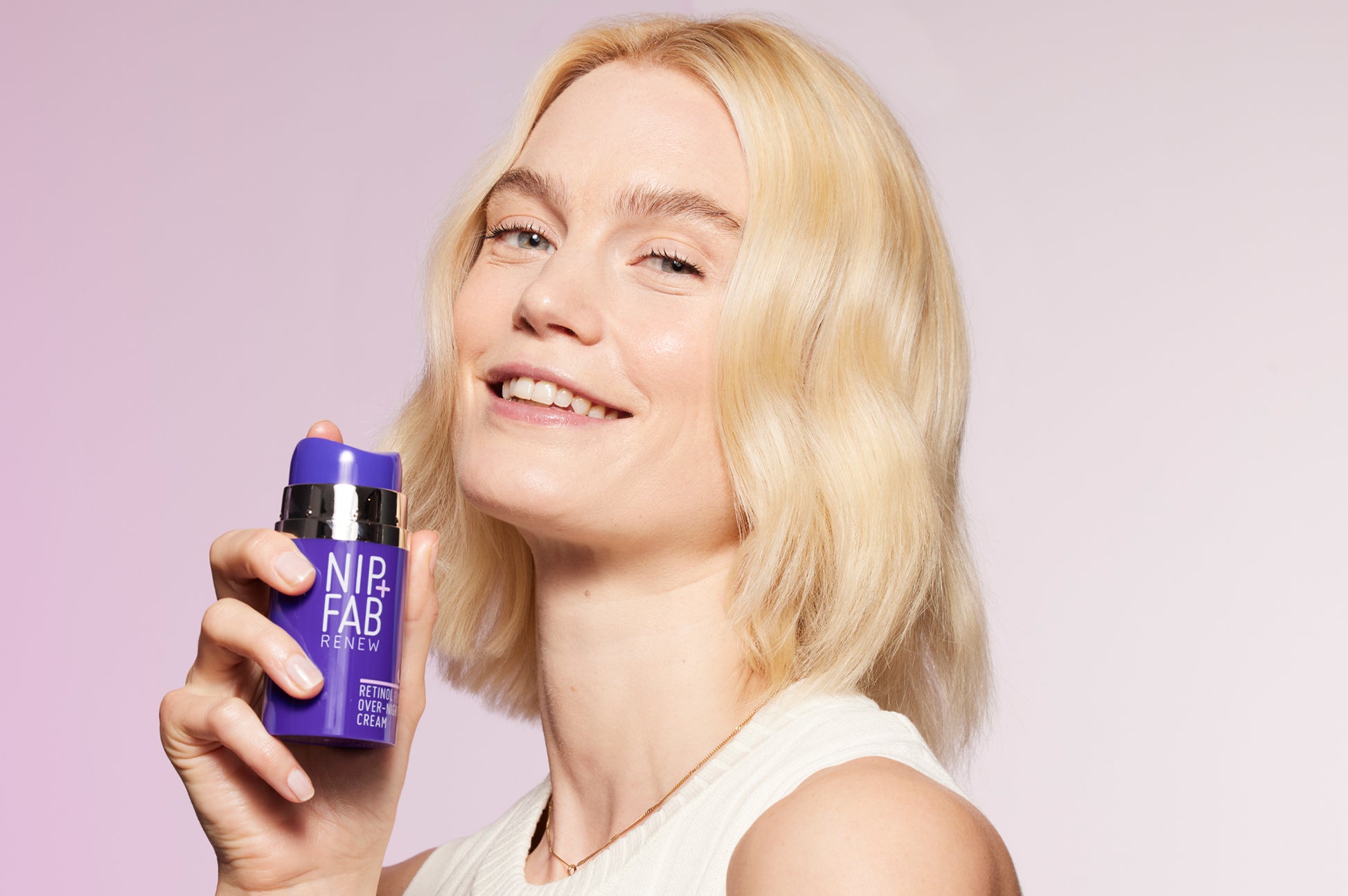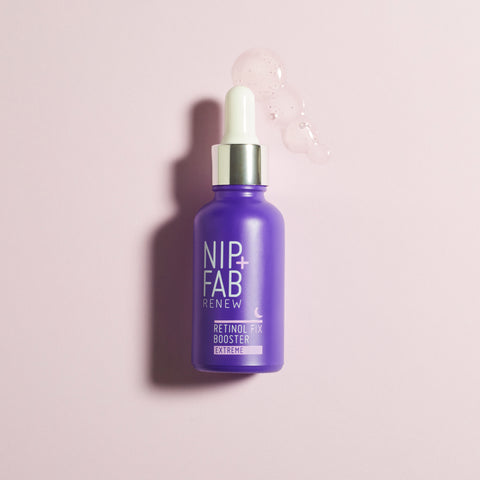


If you’ve got a passion for skincare then you’ll definitely have heard about retinol. Hailed as a ‘magical’ product for its ability to help with the significant reduction of acne, hyperpigmentation and signs of ageing, it’s no wonder why this skincare miracle has made its way into our beauty regimes.
In this guide we'll cover the following:
What is retinol?
What retinol treats
What does retinol do?
The science part
How much retinol to use
When to start using retinol
Can I use retinol with other products?
How long does it take for retinol to work?
So, what is retinol? Retinol is part of the retinoid family, which is an umbrella term used for all vitamin A skincare derivatives.
There are lots of different types of retinoids, and retinol is just one of these. Similar to how there are lots of different types of fruit, but not all fruit is the same or has the same properties - a strawberry is very different to an orange!
The retinoid family includes products that are available over the counter and on the high street, such as the Nip+Fab Retinol Fix range. Within the retinoid family, there are also products that are much stronger, and can only be accessed with a prescription, such as a topical tretinoin.
Some of the different types of retinoids include:
In our guide, we are going to be talking exclusively about retinol, which is the strongest retinoid that you can get over the counter without a prescription.

Retinol is primarily used to treat the following skin conditions:
Let’s take it back to our biology classes to refresh our brains on human anatomy so we can understand more about what retinol does.
Our skin has three layers and these are:
The epidermis
This is the very outer layer of our skin, which acts as a waterproof barrier and creates our skin tone.
The dermis
The middle layer is called the dermis, this sits beneath the epidermis and contains tough connective tissue, hair follicles, and sweat glands - lovely
The hypodermis
The deepest layer of the skin is called the hypodermis and is made of fat and connective tissue.
Retinol works differently from how many other skincare products work. Instead of simply removing dead skin cells from the outer layer of the skin (the epidermis), the tiny molecules that are in the retinol penetrate down to the middle layer (the dermis).
Once these molecules are in the middle layer, they are able to act on free radicals by neutralising them. Free radicals are molecules that contain oxygen and are characterised by an uneven number of electrons.
The uneven number of electrons means a free radical can easily react with other molecules and this can cause large chain chemical reactions in the body. Neutralising a free radical involves an antioxidant (such as retinol) ‘giving away’ some of its own electrons to the free radicals which help to create an even number of electrons and break the chain reaction.
The retinol is then able to boost the production of elastin and collagen in the middle layer of the skin - and this is what helps to achieve that desirable plumped up skin, improving the appearance of wrinkles, fine lines and enlarged pores.

It’s important to know that retinol comes in varying strengths. Typically, the most common strengths that you will see are; 1%, 0.5%, 0.3% and 0.25%.
Ensure that when you are buying your retinol product that you are aware of the concentration levels, as this will determine how much and how often you should use it.
Our range is of moderate strength, with a 0.3% concentration level across the majority of the retinol fix collection, from our retinol fix sheet mask to our retinol fix booster extreme - which is hailed as beauty sleep in a bottle!
To ensure you are using retinol safely, it is advised to start with a small pea-sized amount. Nip+Fab offers a range of retinol products in various forms and textures to meet the needs of your skin types and concerns.
Top tip: If you are using retinol to help with the appearance of fine lines and wrinkles, we recommend using your retinol products alongside other products that target your skincare concerns to achieve the best results.
For example, incorporating products that contain antioxidants and hydrating ingredients such as hyaluronic acid will allow your skin to remain nourished after using retinol. The Dragon’s Blood Fix collection is our hugely popular range of hydrating and plumping skincare which works great with our retinol range. Apply the morning after a retinol treatment to take your skin’s hydration to the next level.
Remember to wait 20-30 minutes before applying any other products to your face after using retinol!
Retinoids don’t work the same for everyone. If you suffer from rosacea, eczema, or psoriasis, it's best not to use retinol at all, as it can be too harsh on skin that needs a gentle touch.
However, most people should be absolutely fine with using this product, even if you have sensitive skin. Many dermatologists agree that sensitive skin can be trained to tolerate retinol and there are products on the market containing retinol that are specifically designed for sensitive skin.
It is best to introduce retinol to your skincare routine slowly but surely - gradually building your skin's tolerance. It’s advisable to start with products that contain a low to moderate concentration of retinol - between 0.25% or 0.3%, such as the Nip+Fab Retinol Fix range - our retinol fix renew starter kit is the perfect place for newbies to start.
At first, you should limit your initial use to once or twice a week, gradually increasing the frequency as your skin gets used to the product.
If you experience no problems, you can begin to increase your usage to every other day and then every day. As with many other skincare products you may need to experiment to find the best usage for your skin and never continue to use the product if your skin begins to feel irritated.
What age should you start using retinol? While there is no set time to start using retinol, many dermatologists advise introducing the ingredient into your skincare routine in your mid-twenties, especially if you suffer from breakouts or pigmentation.
Around this age is generally when the elastin production in the skin will naturally start to slow down. Elastin is what makes our skin ‘bouncy’ and able to ‘snap back’ into place if you were to pinch it and let go. Our skin's ability to do this is super important in maintaining a youthful appearance.
How to introduce retinol into my skincare routine?
Retinol comes in various forms and textures from retinol serum, to face masks and night cream.
Generally speaking, serums tend to be best for people with oily skin and creams work better for people with dryer skin.
How do you go about introducing retinol into your skincare routine? We’ve got some instructions for the safest and most effective way of completing your retinol regime.
Directions:
You can use retinol with some other products, but it’s not as simple as slapping as many products as you like on at the same time.
Some products are very effective when being used alongside retinol, for example using a moisturising serum such as the dragon's blood plumping serum the morning after using retinol to restore moisture is a must!
On the flip side, using anything that targets acne at the same time as using retinol is generally a no-no, as this mix of products can cause severe irritation.
One of the most common questions people have is whether you can use retinol with vitamin c and the short answer to that is yes, but there are some precautions you should be taking with this. We've got a blog that covers the ins and outs of that topic, if you want to find out more.
The bottom line is that it’s always best to do thorough research around the specific type of product you want to use in conjunction with retinol to find out if it will be safe for your skin and consult a dermatologist or professional for your unique circumstances. Then, if it is safe for you to use on your skin, ensure that you are waiting at least 20-30 minutes after you have applied your retinol before applying any other products.
How long does retinol take to work?
So how long will you be waiting to see the results?
Well, it appears that good things come to those that wait - dermatologists say that it takes an average of 12 weeks for retinoic acid to produce noticeable changes in the skin. So stick with it for at least that amount of time in order to see the benefits.
Remember that using retinol isn’t a race—you could be using retinoids for many more decades as part of your skincare routine and studies have found that even super low-strength retinoids had the same anti-ageing effects on skin as moderate retinoids over the same length of time.
So take it slow, listen to your skin and always ensure you’re wearing a moisturising sunscreen that is at least SPF 30 to protect your skin from harmful UV rays, as your skin is more sensitive to the light after using a retinol treatment.